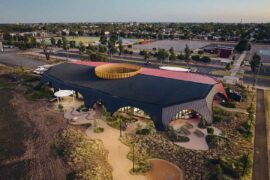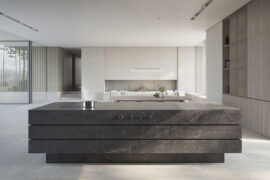Using data compiled from over 100 sources, New York based architecture firm Diller Scofidio + Renfro have created EXIT — a 360-degree video experience that unravels the reality of refugees and global migration, number by number.
We’re all aware the earth is in dire straits — due largely to the hefty footprint of humanity. Diller Scofidio + Renfro’s installation EXIT pieces together that flooring reality, the troubled state of our planet, and the cost of climate change now. The installation has just arrived in Sydney for the first time as part of the program for the Sydney Festival.
Diller Scofidio + Renfro (DSR) are probably best recognised for The Highline — New York’s 2.33km parkway built on to a disused section of above ground railway line in Chelsea and the Meatpacking District. The firm operates as an interdisciplinary studio, drawing in both visual and performing arts into its architectural practice.
EXIT was originally commissioned by Cartier’s contemporary art foundation for its 2008 exhibition, Native Land, Stop Eject — and is based on a prompt by French philosopher and urbanist Paul Virilio. The installation investigates unprecedented numbers of migrants leaving their home countries for economic, political and environmental reasons. To create EXIT, DSR enlisted the help of architect-artist Laura Kurgan, statistician-artist Mark Hensen and a core team of artists and scientists, to both quantify and display what is an alarming and escalating trend.
The result is a feat in data conceptualisation – compiling numbers and statistics from over 100 sources, including UNESCO and the World Bank. Viewers enter a darkened room where they are confronted with a panoramic video screen. A spinning animated globe wipes across the screen, unveiling graphic maps, texts and trajectories — all increasing or decreasing by staggering amounts. In the video, data is divided into six thematic chapters, encompassing population shifts from cities, political refugees and forced migrations, natural disasters, rising seas and sinking cities, loss of languages and culture, and the impact of immigrants sending money home. An audible tick-tick sound of data compiling makes the piece and its truths all the more formidable.
And the stats are staggering. Since 2008, natural disasters have displaced on average 26 million people per year, which equates to one person every second. Due to deforestation and the destruction of indigenous people’s livelihoods and cultures, more than half of the 6,700 languages still spoken today are in danger of extinction by the end of the century.
The geo-coded data used to design EXIT was updated in 2015 — making its relevance all the more direct and poignant for right now. The data art piece, and its disturbing statistical birds eye view reality stunned the 2015 United Nations Conference on Climate Change (COP21) in Paris where it was exhibited at Palais de Tokyo. DSR have visualised an important forecast for the future of the planet, and one that only seems more urgent now than ever.
EXIT is at UNSW Galleries from 7 January until 25 March.
INDESIGN is on instagram
Follow @indesignlive
A searchable and comprehensive guide for specifying leading products and their suppliers
Keep up to date with the latest and greatest from our industry BFF's!

At the Munarra Centre for Regional Excellence on Yorta Yorta Country in Victoria, ARM Architecture and Milliken use PrintWorks™ technology to translate First Nations narratives into a layered, community-led floorscape.

For those who appreciate form as much as function, Gaggenau’s latest induction innovation delivers sculpted precision and effortless flexibility, disappearing seamlessly into the surface when not in use.

In an industry where design intent is often diluted by value management and procurement pressures, Klaro Industrial Design positions manufacturing as a creative ally – allowing commercial interior designers to deliver unique pieces aligned to the project’s original vision.
The internet never sleeps! Here's the stuff you might have missed

Eco Outdoor recently brought together developers, sustainability experts and local architects such as Adam Haddow to discuss design fundamentals, carbon targets and long-term thinking.

The Simple Living Passage marks the final project in the Simple World series by Jenchieh Hung + Kulthida Songkittipakdee of HAS design and research, transforming a retail walkway in Hefei into a reflective public space shaped by timber and movement.